|
|
Post by PinkFloyd on Aug 5, 2011 20:23:52 GMT
Frans, I am contemplating replacing the 4 x 2200uF with similarly sized 4700uF and "believe" that this will bring about an improvement (overall).... not so much the "quality" of the capacitors in this position that count but the "amount" of capacitance..... I would like to slot in 40,000uF (4 x 10,000uF) but the MOST I can get on board (without destroying the aesthetics) is 18,800uF (4 x 4700uF). You are the designer of the amp and I would appreciate your take on this. Obviously the amp is designed to a parts "budget" and you have to keep tight to that budget in order that the amp remains a good value kit amp, BUT..... do you think it would be advantageous to fit 4700uF instead of 2200uF? I don't normally ask (and just do it;)) but I have massive respect for you and would like your take on the benefits of MORE capacitance in these areas.... Personally, I think that more equates to better (as I have found with the X-CAN amps).... sonically, it provides a more open window on the sound and ALSO helps "reduce" any noise that may be present. From what I can see an extra few thousand microfarads won't do any harm and may just do a bit of good  Mike. |
|
|
|
Post by Garage1217 on Aug 5, 2011 21:39:36 GMT
Just my input.... 4700uF per cap is fine on the power supply side, I would not change the output values at all, leave them at 2200uF but feel free to use whatever cap you like. Also it actually was not the cost to go to a 4700uF on the power supply, they are actually cheaper than the FG nichicon 2200uF units by almost 1/2  I just did not hear any difference at all when trying 9400uF + worth of capacitance so opted for very nice FG dual 2200uF capacitors all around. Others may feel different so feel free to use whatever you like the the PS side! The footprints accept 5, 7.5 and 10mm in that location  Not sure which brand you want to use on the power supply but I can supply a part number for an FW series nichicon that is 4700uF and the exact same size as the 2200uF FG cap and is a direct replacement. "18mm x 35.5mm" from memory. |
|
Deleted
Deleted Member
Posts: 0
|
Post by Deleted on Aug 5, 2011 22:12:04 GMT
It was Jeremy's idea to put in 2 smaller sized caps (I had only 1 in my schematic). It also brings 'symmetry' to the eyes... more of a dual mono idea.. and fully agreed with this decision. Technically 2X 2200 in parallel have a lower HF impedance than 1 4700uF The bigger, the lower the impedance for lower frequencies, but the worse the impedance for HF (talking MHz here for decoupling) Since the Sunrise is full class A the 'audio power' doesn't come out of the caps but from the 'reservoir current' in the end stage, contrary to beliefs popular in DIY sites. For AB type amps I would agree more (uF) is better (upto a certain point) a simple experiment shows this. put a (small) resistor in series with the power supply lines (between reservoir caps and amp part) and connect an audio amplifier (via coupling caps) to that resistor and simply listen (no measurements, just ears) if you hear something. IF you do then you know audio must come from the caps. IF you don't hear anything the caps/power supply can't have that big an influence too as no audio is drawn only DC. I did these tests, because I liked to know how the 'ripple' on the power supply 'sounded'. Some amplifiers get unstable with an added resistance so this must be checked with a scope and taken care of with extra decoupling in some cases. In pure class-A NO audio is drawn from the power supply, clean as a whistle, only DC is constantly drawn from the power supply. MUCH more current than is ever needed by the headphone so there is always 'room to spare'. In AB-class it IS audible and certainly not 'nice' to listen to too (half wave rectified audio... yuck). The regulators behind it have SERIOUS work to do (most 'normal' regulators fail in that aspect b.t.w. as Alex correctly to points out) but they are very good for class-A operation (although Alex has different views) as the current is constant so no ripple is actually there. For power loudspeaker amps LOADS of uF can supply the needed 'audiocurrent' and 'more' is generally better. Again, untill a certain point is reached where the rectifiers and trafo get the beating. But don't let these technical things discourage you and experiment away.  It's what DIY is all about after all.  |
|
|
|
Post by PinkFloyd on Aug 5, 2011 22:14:07 GMT
Hi Jeremy 10,000uF would be even better..... just awaiting Fran 's take on it...... I am not "asking" now, I am telling you that 10,000uF is better than 2200uF  |
|
|
|
Post by PinkFloyd on Aug 5, 2011 22:18:01 GMT
It was Jeremy's idea to put in 2 smaller sized caps (I had only 1 in my schematic). It also brings 'symmetry' to the eyes... more of a dual mono idea.. and fully agreed with this decision. Technically 2X 2200 in parallel have a lower HF impedance than 1 4700uF The bigger, the lower the impedance for lower frequencies, but the worse the impedance for HF (talking MHz here for decoupling) Since the Sunrise is full class A the 'audio power' doesn't come out of the caps but from the 'reservoir current' in the end stage, contrary to beliefs popular in DIY sites. For AB type amps I would agree more (uF) is better (upto a certain point) a simple experiment shows this. put a (small) resistor in series with the power supply lines (between reservoir caps and amp part) and connect an audio amplifier (via coupling caps) to that resistor and simply listen (no measurements, just ears) if you hear something. IF you do then you know audio must come from the caps. IF you don't hear anything the caps/power supply can't have that big an influence too as no audio is drawn only DC. I did these tests, because I liked to know how the 'ripple' on the power supply 'sounded'. Some amplifiers get unstable with an added resistance so this must be checked with a scope and taken care of with extra decoupling in some cases. In pure class-A NO audio is drawn from the power supply, clean as a whistle, only DC is constantly drawn from the power supply. MUCH more current than is ever needed by the headphone. In AB-class it IS audible and certainly not 'nice' to listen to too (half wave rectified). The regulators behind it have SERIOUS work to do (most 'normal' regulators fail in that aspect b.t.w. as Alex often likes to point to) but are very good for class-A operation (although Alex has different views). For power loudspeaker amps LOADS of uF can supply the needed 'audiocurrent' and 'more' is generally better. Again, untill a certain point is reached where the rectifiers and trafo get the beating. But don't let these technical things discourage you and experiment away. It's what DIY is all about. 4700uF x 4 it is then  I will report back as soon as I have fitted the extra capacitance  |
|
Deleted
Deleted Member
Posts: 0
|
Post by Deleted on Aug 5, 2011 22:20:13 GMT
keep the wires SHORT and THICK if you want to reach LOW impedance. It IS low (impedance) on the PCB with it's short, thick wires and very low-Ohmic groundplanes (top AND bottom side)  |
|
|
|
Post by PinkFloyd on Aug 5, 2011 22:25:15 GMT
keep the wires SHORT and THICK if you want to reach LOW impedance. My stash of 4700uF are pitch perfect.... lead inductance is not a problem.  |
|
Deleted
Deleted Member
Posts: 0
|
Post by Deleted on Aug 5, 2011 22:30:44 GMT
Do they fit through the top plate ?
|
|
|
|
Post by PinkFloyd on Aug 5, 2011 22:37:46 GMT
Do they fit through the top plate ? Yes. |
|
mrarroyo
Been here a while!  Our man in Miami!
Our man in Miami!
Posts: 1,003
|
Post by mrarroyo on Aug 5, 2011 22:57:20 GMT
Well ... where are the pictures?  |
|
mrarroyo
Been here a while!  Our man in Miami!
Our man in Miami!
Posts: 1,003
|
Post by mrarroyo on Aug 5, 2011 22:58:03 GMT
I mean 20+ minutes have lapsed.
|
|
Deleted
Deleted Member
Posts: 0
|
Post by Deleted on Aug 5, 2011 23:02:24 GMT
Agreed. However when the Class A bias is fairly high, the higher ripple from the PSU can degrade the performance unless extra measures are taken. Just fitting additional power supply electros in parallel normally only gives a slight improvement. In some cases it may be better to regulate the PSU after the reservoir capacitors.
Alex
P.S.
I am speaking in general terms here, and not specifically about this project.
|
|
Deleted
Deleted Member
Posts: 0
|
Post by Deleted on Aug 6, 2011 7:58:05 GMT
Mike,
I'll put the Sunrise back in post to you on Monday so you have something working in front of you. Now I've heard it, I know what we're talking about but in the meantime, you can have a play with it.
In some cases it may be better to regulate the PSU after the reservoir capacitors.
Alex, are you talking about inhibiting mains noise here?
Ian
|
|
Deleted
Deleted Member
Posts: 0
|
Post by Deleted on Aug 6, 2011 8:07:13 GMT
Hi Ian
I am mainly referring to Class A SS amplifiers here, like my 15W/Ch Class A which has a standing current of 1A on each channel.
At those much larger currents, PSU 100HZ ripple is much higher as you would expect.
Alex
|
|
Deleted
Deleted Member
Posts: 0
|
Post by Deleted on Aug 6, 2011 8:28:57 GMT
Edit: Alex made a post at the same time as I did.
Alex is talking about reducing hum (a 50/60 - 100/120Hz) that is always present on reservoir caps directly after rectifying.
The higher the drawn class A current, the bigger this AC voltage.
The larger the reservoir caps the lower this voltage.
This is important IF the amplifier has a poor 'Power Supply Rejection Ratio'
a poor PSRR means residual hum (or audio related dips because power is drawn in AB amplifiers) after rectifying that is present on the caps becomes audible in the signal path.
The Sunrise has poor PSRR and thus needs either a switch mode power supply or a linear regulated one.
with a high PSRR garbage on the power supply lines does not (or at very low levels) enter the audio path.
Since the Sunrise is fed from either a switch mode power supply (which also has a slight ripple but at around 60,000 -100,000 Hz so faster than we can hear the reservoir caps are replenished already.
Mains noise it cannot filter because mains noise is almost always common mode which you cannot filter.
common mode noise is a voltage ( containing a wide range of very high frequencies) that is equal in amplitude and phase on BOTH power supply lines.
So when you measure between the power supply lines you measure/see NOTHING (as it cancels itself out) BUT when you measure between either the phase or neutral wire and ground you WILL see a lot of garbage.
This is NO problem if you only have 1 device which is used stand alone but IS a problem when 2 separately fed devices (with different internal leakage currents) both have different voltages on them.
These will want to 'equalise' once connected and do so via the interlinks.
Actually through the SHIELDS of the interlinks.
This causes a current that can result in a voltage on the input of 1 of the devices which can cause problems.
Another 'path' that could potentially cause 'equalising currents' that can become audible comes from leakage from a stand alone device that works it's way through the ground/common of the device THROUGH your body and this happens when you touch that device.
You create the current path at that moment and is broken again when you let go.
This is most obvious with a high input impedance (open inputs, nothing connected, or middle volume setting with linear pot or 2-3 o'clock setting with a log vol pot.
When a high impedance is present a very small current can already become audible.
So filtering garbage (common mode with special common mode filters) is beneficial.
You can filter each incoming device (that needs it) or simply filter the source so you don't have to filter the rest.
problem is there are LOTS of garbage creating devices which one does not know anything about so filtering at the input can be beneficial if the mains is already 'dirty'
leakage currents can be/are higher in switch mode power supplies than when transformers are used.
But transformers also simply 'conduct' HF common mode signals almost without any attenuation due to it's capacitance (wires being close together creates a capacitance).
I hope I made this (very difficult and hard to grasp) common mode garbage thing a bit more down to earth/understandable.
|
|
Deleted
Deleted Member
Posts: 0
|
Post by Deleted on Aug 6, 2011 9:04:48 GMT
It is complex.
So I assume that we're talking about a constant 'hum' on the note 'G' (out of tune slightly), rather than something that can be altered in amplitude by hand proximity or touching an earth? In other words - mains hum getting into the audio line?
Ian
|
|
Deleted
Deleted Member
Posts: 0
|
Post by Deleted on Aug 6, 2011 9:38:48 GMT
Ian
When using a full wave or bridge rectifier, the ripple frequency is double the mains frequency. i.e. 100HZ with 50HZ mains, and 120HZ with 60HZ mains.With half wave rectification the ripple freqency is 50HZ with 50HZ mains, and 60HZ with 60HZ mains.
The ripple is a little raspy sounding though, but I won't go into that here. The majority of audio devices normally use full wave or bridge rectification.
Alex
|
|
Deleted
Deleted Member
Posts: 0
|
Post by Deleted on Aug 6, 2011 9:55:01 GMT
Thanks Alex,
I was trying to differentiate how it sounds:
ie The 'G' note that we can get on UK mains. (Mains hum) or that (as you say) 'rasp' which is like AC tacking away.
The Sunrise' weakest aspect (I would say is noise rejection - I'm not sure it's air-born) but it's sound is gorgeous. (Although not as extended in the treble as some)
This 'noise' thing is quite complex given different places that it's going to be used in, all over the world. For instance, Mike is in a mostly 'clean' area as far as noise is concerned whereas not only do I live in a relatively more 'dirty' mains area, but I'm on the end of the line so to speak in that I live out of any villages or towns. Even getting an internet signal (and phone) is problematic but I also have electrical equipment in the house.
The variation of environments that these things would be played in is quite huge so I guess with an open valve design, this has to be taken into consideration since we could be experiencing a totally different thing in a different place!! ie; it can't be replicated on test in a different area.
As you know, noise rejection seems very important to me. Maybe I'm too analytical about this aspect, I don't know.
I do know that it's possible to make a valve amp dead silent here though because Mike did something to my V2 which totally knocked everything on the head following his first mods - when I listened, the sound was brilliant but I could detect some 'electrical' noise. Mike was able to totally bang it on the head so it is possible.
BTW - the noise issue is something in common with Bravos/Indeeds/Miridiys etc but the Sunrise is superior to them all. I just wonder whether it's possible to get the noise levels down to my V2 level.
Ian
|
|
Deleted
Deleted Member
Posts: 0
|
Post by Deleted on Aug 6, 2011 10:06:35 GMT
Ian Even if Mike isn't able to duplicate your problems, he knows all the tricks in reducing susceptibility to mains borne crap. I once tried making a battery operated preamp to increase the sensitivity of my CRO to check the noise level out of a JLH,but despite all the screening tricks I wasn't able to use it for that purpose due to high levels of mains interference in the room. Add to that high levels of RF from nearby FM broadcast transmitters etc.  |
|
Deleted
Deleted Member
Posts: 0
|
Post by Deleted on Aug 6, 2011 10:24:01 GMT
Interference is smaller in V2 as the power supply is different (Pinky has some filtering) AND it is not an open frame but nicely shielded.
Noise levels as in background hiss cannot become as low as V2.
It's best to select a tube with low noise.
Noise emits from the tube mainly, and the relatively low anode voltage doesn't help either.
The V2 differs considerably from the Sunrise/miri... etc.
The V2 has overall feedback and less gain (because of that).
Feedbak increases bandwidth, lowers noise, but also lowers the 'sought after' tube 'added distortion'.
Since the overall feedback is not that 'vigurous' in the V2 a lot of the valve character remains and hiss will only be a few dB less.
That few dB might just be enough to make the amp appear to have no noise (hearing treshold) and the Sunrise/miri/indeed/bra.... thingies to have more.
|
|
Deleted
Deleted Member
Posts: 0
|
Post by Deleted on Aug 6, 2011 10:24:57 GMT
Hi Alex, Yes, that's for sure!! It's not just the Sunrise though - I even had similar problems with a system that was installed for me to trial (very posh, eh?) and the guy installing was doing all kinds of things to alleviate it. Trouble is, these guys don't want to tell you what they're doing for some reason!!  (Me being nosey and all that) He got it, but it's an annoying thing to think that you could buy commercial gear that needs tweaking once you get it in the house!! In this case, I was just aware of a 'presence' when the system was turned on. Well, you can guess the scenario with the dealer saying 'no - this is inky black' etc., when I could tell for sure that something was on. The guy who installed it came back and at first said he could hear 'nothing' and then when I described it to him, he suddenly heard it!!! Very slight, very low level ac type noises - like a 'fizz'. For something he couldn't hear, he did a good job getting rid of it!! Ian |
|
Deleted
Deleted Member
Posts: 0
|
Post by Deleted on Aug 6, 2011 10:30:51 GMT
If it was a constant fizz it was very likely common mode currents.
proper filtering (the correct filters at the correct place) eleviates those problems.
In some cases all it takes is a well placed ferrite or simple filter.
I can tell you with certainty that common mode issues are NOT even understood by a LOT of technical guys.
It borders on magic it seems even for technical guys, but is simply a matter of 'visualising' the current paths and knowing what filter does what in what circumstances.
Simply adding a 'commercial' mains filter might help in some cases but in others it might even make things worse, or do very little.
|
|
Deleted
Deleted Member
Posts: 0
|
Post by Deleted on Aug 6, 2011 10:50:25 GMT
Yes, I'm not sure whether he was in denial or whether he truly couldn't detect it. They also have a tendency to trying to 'bully' the customers into accepting that it's not there!!! I guess you have to be a sensitive little fairy like me to hear these things.....  It takes a certain sensitivity to both physical sound as well as the technicalities of of minor adjustments. Let alone trying to accept what someone else perceives as a good sound where the technical guy may not necessarily agree. That's one reason why I rarely go to a business for help. They are missing one important ingredient - the ability to empathise with someone else's ears and help. Of course, their time is money and that's the first thing on their mind and to some extent, the growth of BADA in the UK has tried to address this by providing proper listening conditions within a commercial shop. However, the pressure to buy is normally there and also the use of someone's time makes you feel guilty and then kind of under obligation to buy the damned gear!!! That's where the real 'clever' guys have the market as far as I'm concerned. They introduce a kind of 'art' into their work where they have the ability to 'taylor' stuff. (Or maybe I'm a looney and we all should just listen to NADs and Naims because consensus says so!!) I would definitely say that anyone interested in good sound needs to hear a top quality reference system so that they know in which direction to head or they end up taking wrong roads all of the time; open to dealers whims; and forever changing everything in order to find the road again which is basically guesswork because they don't know where they're heading!!! Anyway, I'm rambling again. You've done a fantastic job on the Sunrise and I'm a nit-picker with a microscope.  Interference is smaller in V2 as the power supply is different (Pinky has some filtering) AND it is not an open frame but nicely shielded. Interference is smaller in V2 as the power supply is different (Pinky has some filtering) AND it is not an open frame but nicely shielded.
Noise levels as in background hiss cannot become as low as V2.
It's best to select a tube with low noise.
Noise emits from the tube mainly, and the relatively low anode voltage doesn't help either.
The V2 differs considerably from the Sunrise/miri... etc.
The V2 has overall feedback and less gain (because of that).
Feedbak increases bandwidth, lowers noise, but also lowers the 'sought after' tube 'added distortion'.
Since the overall feedback is not that 'vigurous' in the V2 a lot of the valve character remains and hiss will only be a few dB less.
That few dB might just be enough to make the amp appear to have no noise (hearing treshold) and the Sunrise/miri/indeed/bra.... thingies to have more.Sorry Frans, I missed this post and you've really explained a lot there. So my X-Cans are filtered via Little Pinkies to some extent as well. The V2 does indeed have less gain which is why I was asking somewhere earlier about the gain of the Sunrise since it is extremely loud and most of the noise is above 2 o'clock. Maybe half of that could be 'covered' with reduced gain? However, no feedback means that it is louder and has less bandwidth which is possibly what I was referring to when I said it's not as extended. You know ... what you were saying about translating what I said into technical terms is working the other way round for me now since I understand a lot more about what I'm hearing from the Sunrise as a result of what you've written. For me, the gain is high. I use it at about 9 o'clock mostly so from 10 o clock onwards is basically theoretical 'noise'. I would listen to orchestral at about 11 to 12 o clock which is closer to the noise but still 'theoretical'. To put it crudely, if the volume stopped at 2 o clock and that was the limit, it would be perfectly loud enough and the noise that I get wouldn't exist!!  For people reading this; I am a nitpicker and this is not meant to hurt the Sunrise reputation. It is a SUPERB sounding amp and I am getting one myself since the one I have is on loan. The more you listen, the more you get that 'tubey' sound with a lovely clarity above the gorgeous bass quality. I would say that this is a fantastic introduction to a tube amplifier and its sound potential; possibly leading you to take a leap into the very expensive designs that exist, based around tubes. I think that the improvements on the Chinese designs are massive and wouldn't waste my money on those lesser designs now. Thanks for the explanations, Frans. Ian |
|
|
|
Post by Garage1217 on Aug 19, 2011 4:17:46 GMT
|
|
|
|
Post by PinkFloyd on Aug 23, 2011 19:37:11 GMT
Ian, Just to let you know that your parts arrived yesterday and I made a start on the amp this evening. The valve shields I have incorporate a ceramic base with tag connectors, so not suitable for mounting on the Sunrise board, so I modified the bottom part to incorporate the stock Sunrise ceramic base.... involved a bit of cutting and epoxy resin but got there in the end  OK.... here is the modified base which has a bayonet lock on it: 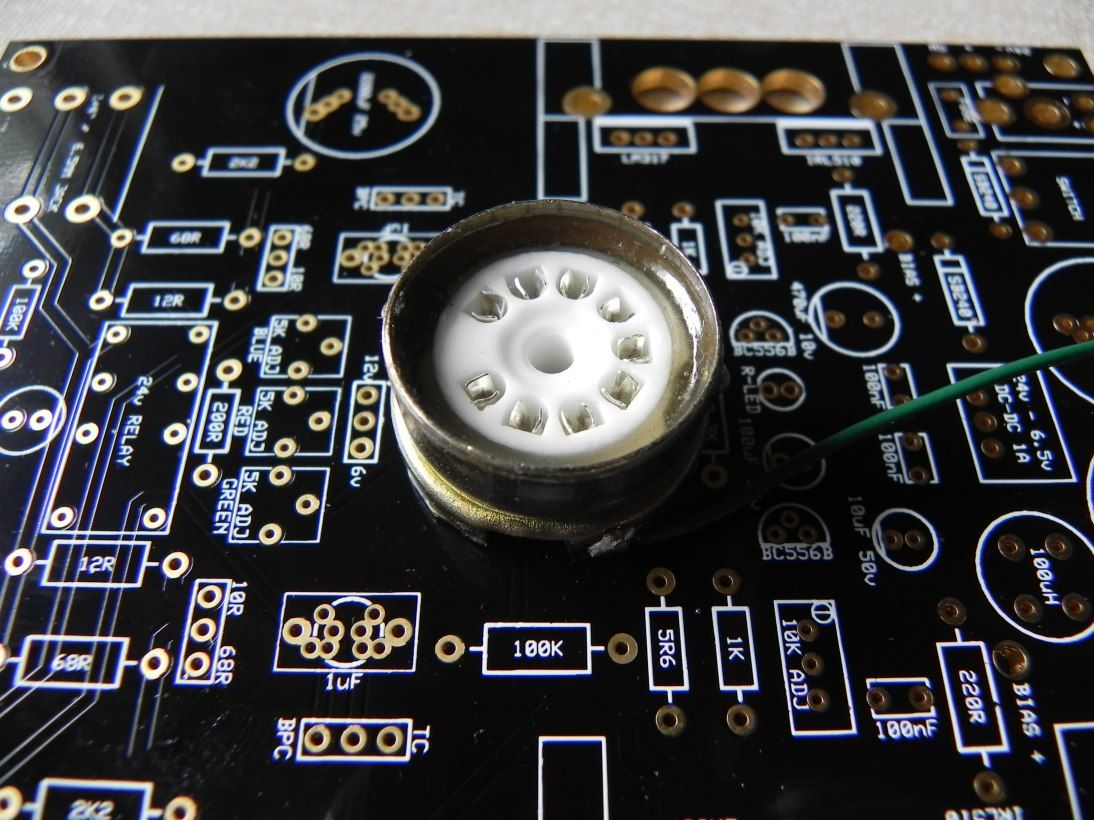 I have soldered a wire onto the side of the base which will be connected to ground somewhere (probably the ground side of the nearest resistor).... the valve is then fitted in (as normal) : 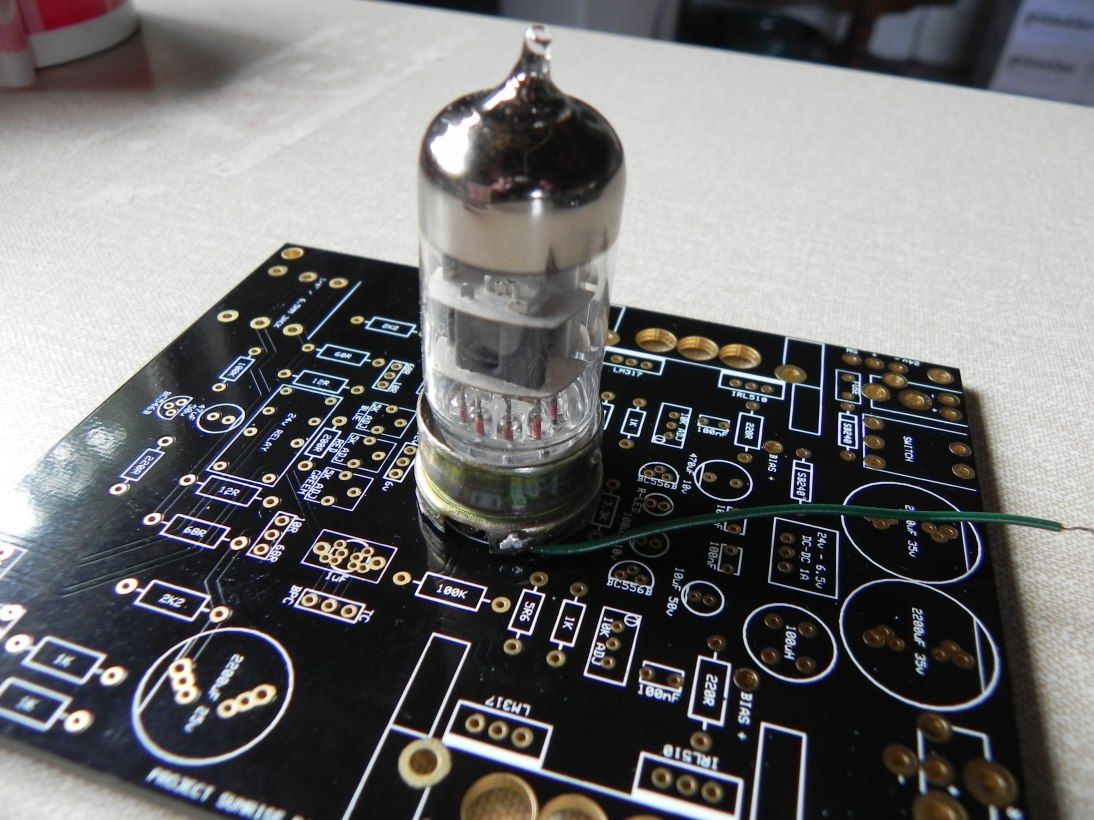 And then you simply fit the spring loaded shield onto the base: 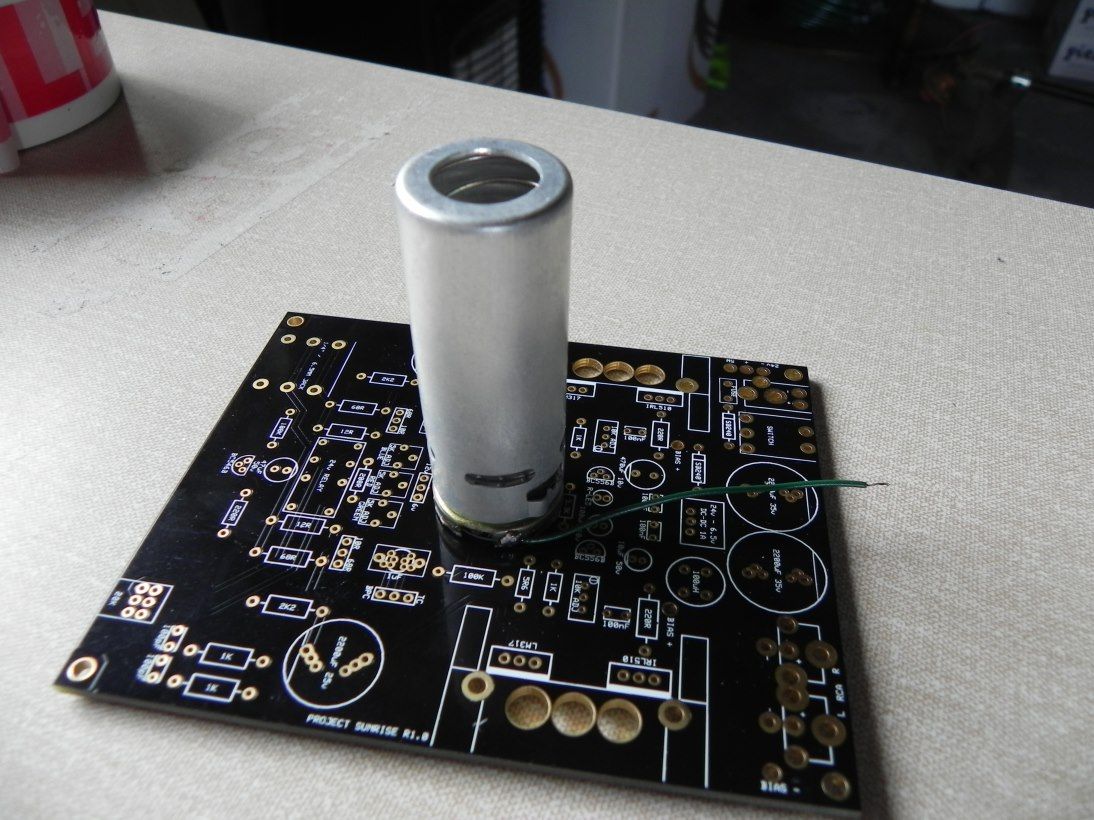 This will have to be done with the top cover OFF as the locking part of the shield won't make it through the hole.... so, fit the shield, and then fit the top cover.... not a problem  I'm not sure if the fancy lights will shine out of the top (haven't tried that yet) and if you would prefer the colours to the shield then just remove the shield  I have grounded the pot body onto the ground side of one of the 100pF caps so that will be dead silent when you touch it now: 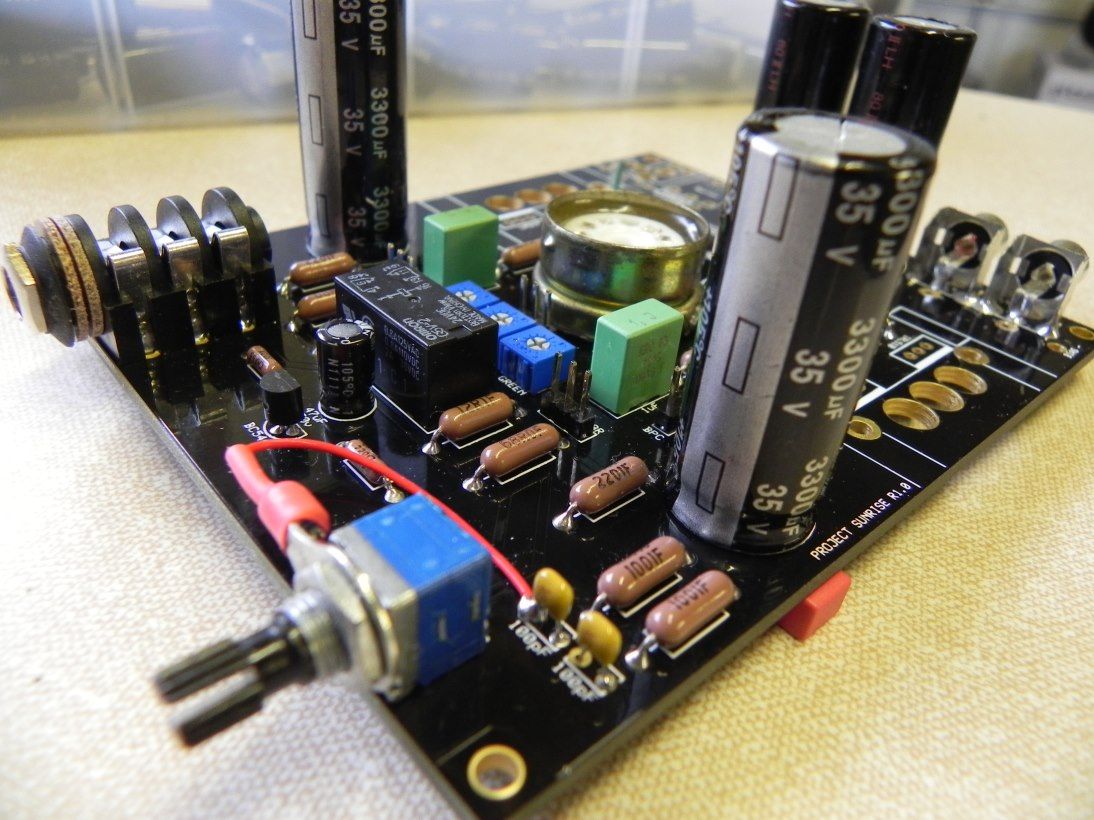 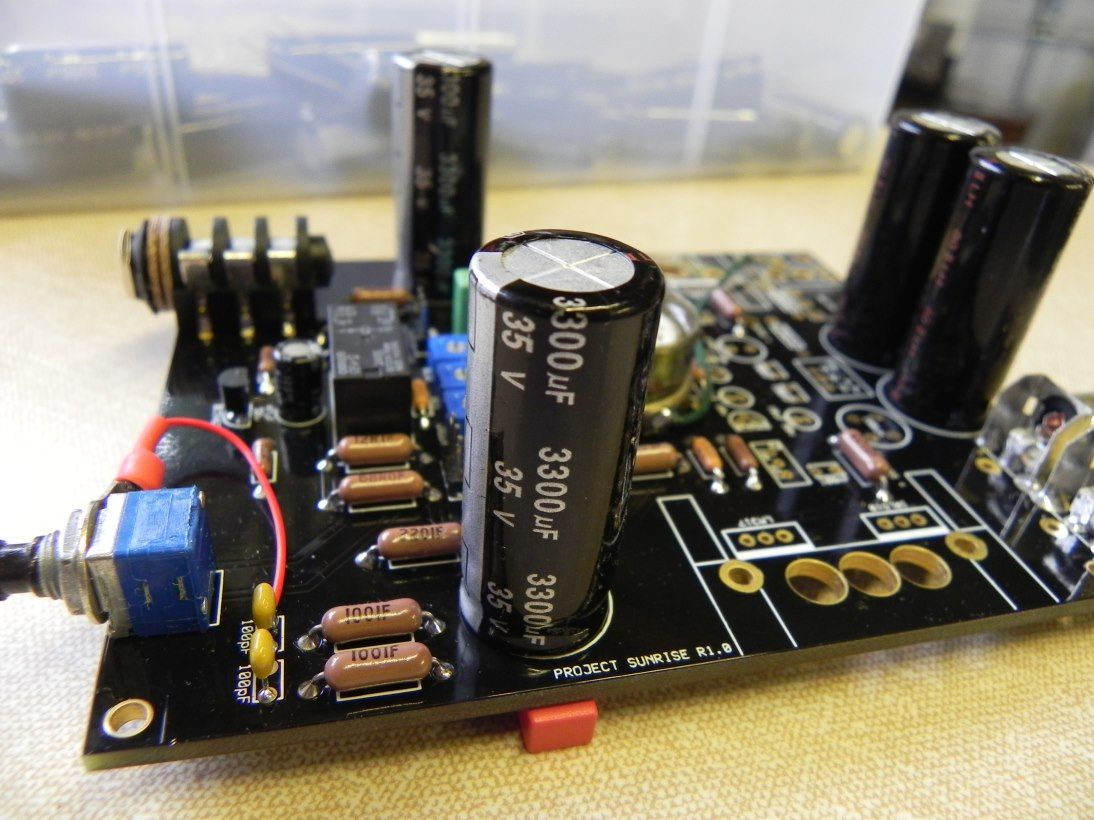 Will also be using your amp as a guinea pig Ian but will only send it to you with revisions if I think it sounds better than my own stock Sunrise amp.... if not, I will retrofit the stock parts. You know that I am a great lover of "capacitance" and, generally, am of the opinion that more is better (in certain areas)..... well, I have fitted 3300uF / 35V in place of the stock 2200uF and have bypassed them (under the board) with WIMA 3.3uF film caps (I may even add on some 330pF polystyrene film caps, if they sound good). I am using Panasonic NHG (105C rated) as they are the only 3300uF / 35V cap that will fit... most of my other 3300uF / 35V are short, stubby bastards. I know that "looks" are not important (not to me anyway) but must confess the black and silver NHG's really do compliment the black Sunrise PCB.... they look a bit meaner than the Nichicon Fine Gold bling livery  3300uF Panasonic NHG bypassed with WIMA 3.3uF: 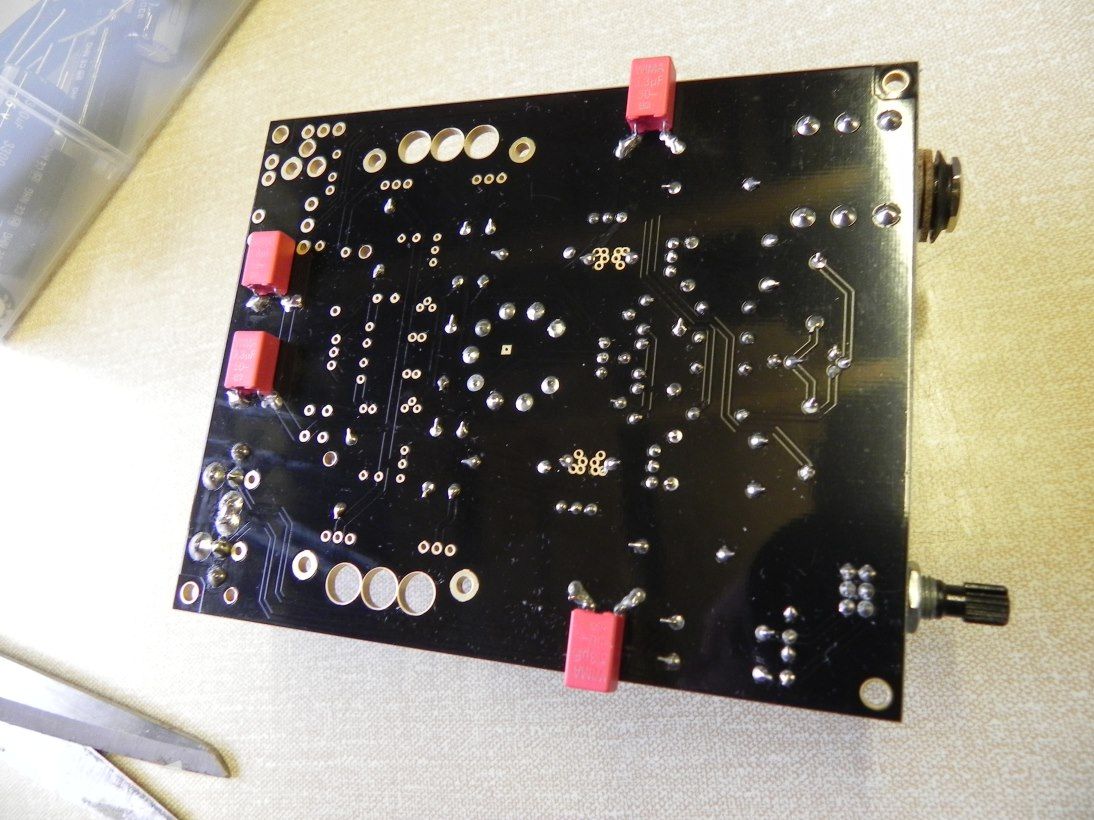 Overhead shot of the build so far:  I'll have the amp fully built up tomorrow morning and will keep you posted, it will ready to ship "built and tested" when you return from Bergerac land (By the way, they don't have such a thing as a "working man's club" on Guernsey so I can only assume you are doing a Women's Guild Gig?  ) Jesus man, you lucky sod! All those grannies throwing their soiled knickers in your general direction  Anyhoo....... will keep you posted. Frans.... with regards to the 1uF input caps..... 1uF seems a bit low to me? Wouldn't 4u7 (or even a 10uF non polar) be a better value? Of course, 10uF would have to be a non polar electrolytic due to space but the WIMA 3.3uF / 50V film cap is a bit smaller than the stock 1uF film cap that comes with the kit..... Of course, I will experiment with input caps but 1uF just seems a bit close to the bone to me (basing my observations on "ear testing" over the years)..... No cap is supposedly the "best" cap but I have found (again, in certain amps) that they sound better (ie: the signature changes) WITH a certain brand of cap in the path.... "house sound" as Rick would have said  I tried the 1uF in my Sunrise amp and then tried a 3.3uF.... the 3.3uF (to my ears) really did allow more "presence" through, especially in the bottom registers.... it may have been placebo but I will now be able to tell as I have another one to compare it to  Actually, Ian..... I'll send you both amps along with my little comparator and you can flick between them both.... Haven't used it in years but it's a nifty little gadget  Mike. |
|